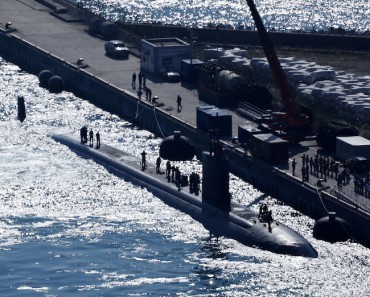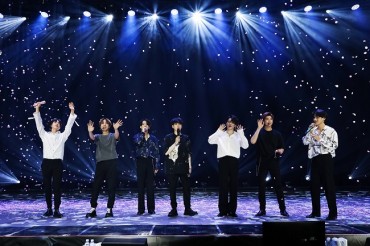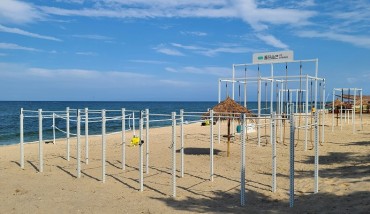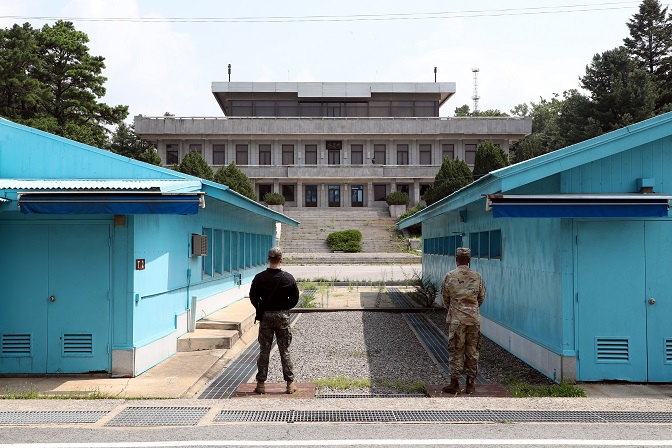
South Korean and U.S. soldiers are on guard at the Joint Security Area of the inter-Korean truce village of Panmunjom on July 19, 2022, when its tour reopened after years of suspension due to the pandemic. The Defense Daily provided this photo.
PAJU/SEOUL, July 19 (Korea Bizwire) — About four years ago, the inter-Korean truce village of Panmunjom was brimming with renewed hopes for peace, as a rare summit between the two Koreas took place there, diluting its image of cross-border tension, albeit temporarily.
But such hopes appeared to be fading amid COVID-19 and uncertainties in inter-Korean ties, as reporters on Tuesday’s media tour saw North Korean troops wary of cross-border contact and unruly weeds seeming like a sign of Seoul’s hitherto unfruitful peace endeavors.
Reporters were invited to Panmunjom and other parts of the Demilitarized Zone separating the two Koreas, as public tours there resumed after a six-month hiatus on eased COVID-19 restrictions.
Panmunjom was a highlight of the media event, as it was where then South Korean President Moon Jae-in and North Korean leader Kim Jong-un held their first summit in April 2018 and where they joined then U.S. President Donald Trump for a historic three-way encounter in June 2019.
The mood of peace at the site was hardly felt, as the North has staged a series of provocative acts, like missile launches, this year, with current South Korean President Yoon Suk-yeol taking a tough stance on its saber-rattling.
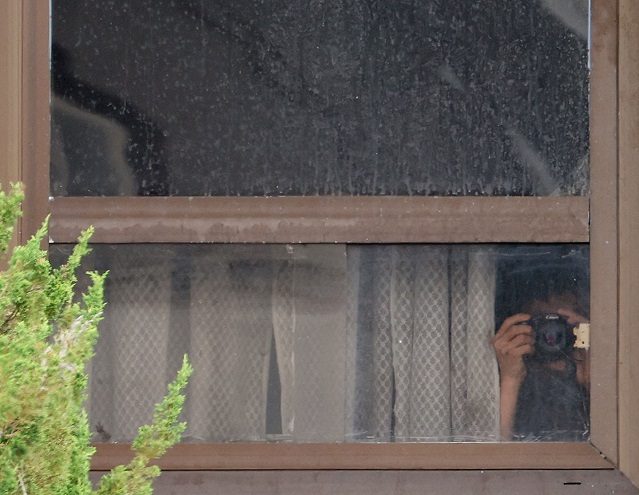
A North Korean official at the Panmungak building, located on the northern side of the truce village of Panmunjom, looks out through the window with a camera facing the South Korean side on July 19, 2022, as tours to the area resumed on July 12. (Yonhap)
Unlike in the past when the prying eyes of North Korean troops kept track of people south of the Military Demarcation Line, none were seen outdoors, a change since the outbreak of the pandemic, according to Lt. Col Griff Hofman, an International Political and Military Affairs Officer at the U.N. Command (UNC).
If necessary, North Korean troops come out, wearing full protective clothing, he said.
For over two years, North Korean personnel were only spotted looking out from the balcony of Panmungak, a North Korea-controlled building, taking pictures, or watching the South Korean side of Panmunjom through binoculars.
Overgrown plants and grass on the North’s side, largely kept well-trimmed before the pandemic, also indicated they have been keeping the area unattended — a reminder of inter-Korean ties that have been stalled for years amid a deadlock in nuclear talks between Washington and Pyongyang.
Before reaching the Panmunjom area, reporters stopped by a guard post, from which the indistinct sight of Kaesong, the North’s border village, came into view.
That sight marked yet another sobering reminder of where inter-Korean relations lie at this point.
The inter-Korean industrial complex there, once a key symbol of bilateral rapprochement, was suspended in February 2016. Kaesong is also home to a joint liaison office that the North blew up in 2020 in anger over the sending of anti-Pyongyang leaflets across the border.

South Korean and U.S. soldiers are on guard at the Joint Security Area of the inter-Korean truce village of Panmunjom on July 19, 2022, as its tour reopened after years of suspension due to the pandemic. (Yonhap)
During the tour, another sight that caught reporters’ attention was the ongoing reconstruction of a bridge used as a venue for talks between Moon and Kim during their 2018 summit there.
The bridge was originally established to connect the Neutral Nations Supervisory Commission camp — an entity to preserve the armistice that halted the 1950-53 Korean War — to Conference Row in the Joint Security Area (JSA).
But ahead of the inter-Korean summit in April 2018, a T-section was added there to enable the outdoor conversation between the two.
Reporters also paid keen attention to the border line, through which South Korean authorities forcibly repatriated two North Korean fishermen against their will in November 2019.
The repatriation is now at the center of a political controversy as the Yoon administration revisited it amid criticism the Moon administration failed to go through due legal procedures for the protection of the North Koreans, though they were suspects in a murder case.
The UNC did not mention the case during the tour as reporters approached the blue T2 building, near which the repatriation took place, as seen in video footage recently released by the unification ministry.
The JSA is an area that is intended for inter-Korean dialogue but is also a place where the risk of danger always exists, Hofman told reporters, as the tour came to an end.
Tours to the program will be held daily at 3 p.m. on Tuesday, Wednesday, Friday and Saturday, with up to 40 people per tour.
(Joint Press Corps-Yonhap)




